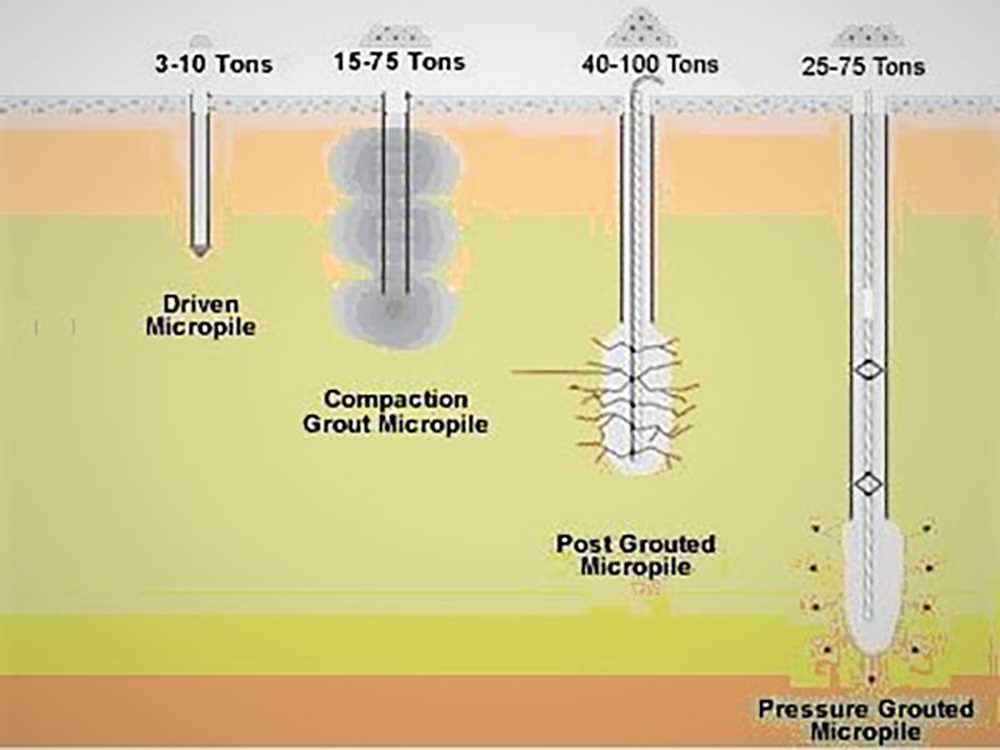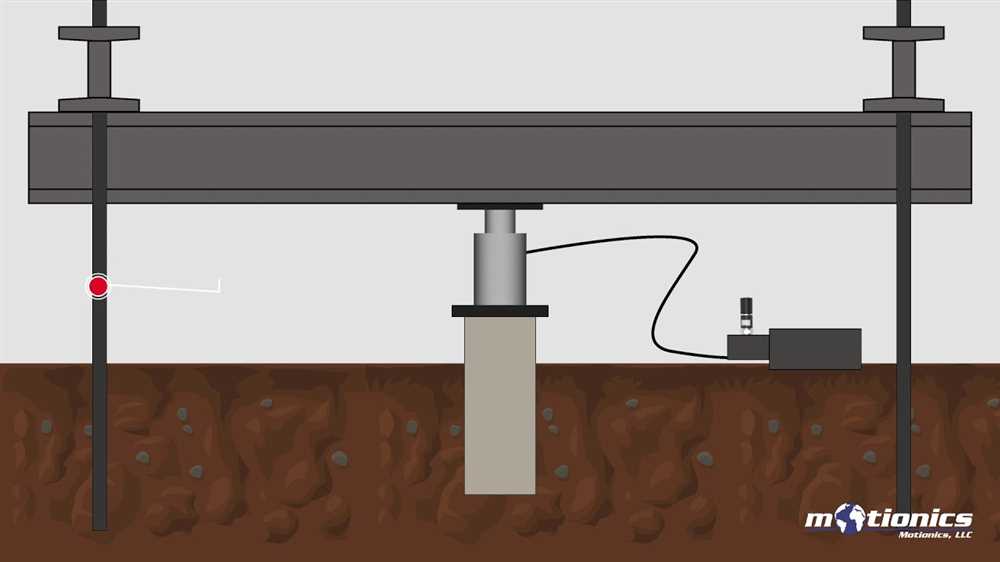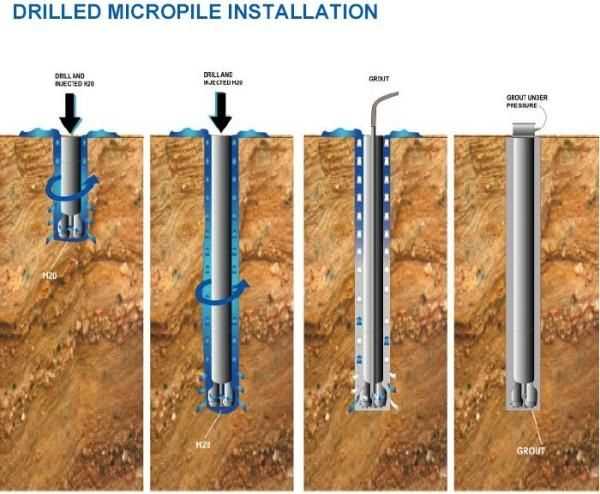
The micropile load test is a crucial step in evaluating the load capacity and structural integrity of deep foundations. Micropiles are commonly used in construction projects where traditional foundation systems are not feasible due to soil or space limitations. These specialized piles provide reliable support and stabilization for tall buildings, bridges, and other large structures.
During the micropile load test, a controlled amount of load is applied to the pile to simulate real-world conditions and determine its ultimate bearing capacity. This test helps engineers assess the pile’s performance under different load levels and identify any potential issues or weaknesses.
The micropile load test involves a series of measurements and calculations to analyze the pile’s behavior. Advanced sensors and instruments are used to monitor the pile’s response to the applied load, measuring factors such as displacement, strain, and load distribution. This data is then analyzed to determine the pile’s load capacity, load-settlement curve, and other important parameters.
By conducting a micropile load test, engineers can ensure that the deep foundation system meets the necessary safety requirements and can handle the anticipated loads. It also allows for adjustments and modifications to be made in the foundation design if required.
Micropile Load Test
In geotechnical engineering, a micropile load test is a method used to determine the load-carrying capacity and performance of micropiles, which are small-diameter, deep foundation elements. These tests are typically conducted during the design and construction phases of a project to ensure the structural integrity and safety of the foundation system.
The micropile load test involves applying a known axial load to a micropile and measuring the corresponding settlement or displacement. This helps engineers understand how the micropile responds to the applied load and whether it meets the design requirements. The test can be performed using either static load testing or dynamic load testing methods.
During a static load test, a controlled and gradual load is applied to the micropile using a hydraulic jack or load cell. The load is increased incrementally and the settlement or displacement is measured at each stage. This information is then used to plot a load-settlement curve, which provides insights into the performance and bearing capacity of the micropile.
In dynamic load testing, a high-intensity impact or rapid loading is applied to the micropile using an apparatus such as a pile driving hammer. The resulting response of the micropile is measured and analyzed to determine its load-carrying capacity. Dynamic load testing can be a more cost-effective and efficient method compared to static load testing, especially for large-scale projects.
Overall, micropile load testing is a crucial step in the design and construction of foundation systems. It helps ensure the structural integrity and safety of the project and allows engineers to make informed decisions regarding the micropile installation and design parameters.
What is a Micropile?

A micropile is a slender, high-strength, small-diameter pile that is used in foundation construction to support structures in areas where traditional foundation methods may not be feasible or cost-effective. It is often used in situations where soil conditions are challenging, such as areas with weak or loose soil, or in locations with limited access or space.
Micropiles are typically constructed by drilling a small diameter hole into the ground and inserting reinforcement, such as steel bars or threaded rods, into the hole. The hole is then filled with a grout material, which provides additional support and stability. The micropile is designed to transfer loads from the structure to the underlying soil or rock, effectively acting as a mini-foundation.
Micropiles offer several advantages over traditional foundation methods. Their small size allows for installation in restricted spaces and areas with difficult access. They can also be installed through existing structures, minimizing disruption to the surrounding environment. Additionally, micropiles can be designed to withstand high axial and lateral loads, making them suitable for a variety of applications, including slope stabilization, underpinning existing structures, and supporting tall and heavy structures.
In order to ensure the integrity and load-bearing capacity of micropiles, load testing is often performed. This involves applying a known load to the micropile and measuring the resulting settlement and deformation. Load testing helps validate the design assumptions, ensure compliance with safety standards, and determine the ultimate capacity of the micropile. Various load testing methods, including axial compression and tension tests, are employed to assess the performance and behavior of micropiles under different load conditions.
Load Testing of Micropiles
Micropiles are deep foundation elements that are used to transfer loads through weak or compressible soils to stronger, more competent underlying layers. These small-diameter piles are typically constructed by drilling into the ground and filling the hole with grout or another material to provide additional strength and stability.
One important aspect of the construction and design of micropiles is load testing. Load testing is a crucial step in the quality assurance process to ensure that the micropiles can effectively support the intended loads. There are various methods of load testing micropiles, each with its own advantages and limitations.
1. Axial Load Testing
Axial load testing is commonly used to measure the load-bearing capacity and deformation behavior of micropiles. During this test, a slowly applied axial load is transferred to the micropile, and the resulting displacements and stresses are monitored. This allows engineers to assess the load-carrying capacity of the micropile and determine its suitability for the intended application.
2. Lateral Load Testing

In addition to axial load testing, lateral load testing is also performed to evaluate the lateral resistance of micropiles. This test involves applying a horizontal load to the micropile and measuring the resulting deflections and rotational stiffness. Lateral load testing helps engineers understand the behavior of micropiles under horizontal loads and enables them to optimize the design for lateral stability.
3. High Strain Dynamic Load Testing
High strain dynamic load testing is a specialized method that involves striking the top of the micropile with an impact hammer and measuring the resulting force and acceleration. This test provides valuable information about the dynamic response of the micropile and allows engineers to assess its load-bearing capacity and integrity.
Overall, load testing is an essential part of the micropile design and construction process. By conducting thorough load tests, engineers can ensure the safety, reliability, and efficiency of micropile installations, ultimately leading to successful foundation projects.
Purpose of Micropile Load Test
Micropile load test is a crucial procedure in geotechnical engineering used to determine the load-carrying capacity and performance of micropiles. Micropiles are deep foundation elements typically consisting of a small-diameter steel pipe or bar grouted into the ground to provide support for structures. The purpose of conducting load tests on micropiles is to verify their design assumptions, ensure their structural integrity, and assess their overall performance under different load conditions.
The primary objective of the micropile load test is to determine the ultimate or safe working load capacity of the piles. This is achieved by subjecting the micropiles to a gradually increasing load until failure or predefined deformation criteria are met. By measuring the settlement, displacement, and load responses of the piles during the test, engineers can evaluate the effectiveness of the pile design and make necessary adjustments if needed. The load test also helps in calibrating the factors of safety used in the design process and provides valuable data for future design considerations.
During the load test, instrumentation such as strain gauges, load cells, settlement gauges, and displacement transducers are used to monitor the behavior of micropiles under load. This allows engineers to gather data on the axial and lateral load capacity, load-displacement behavior, and stiffness characteristics of the piles. By analyzing this data, they can assess the structural performance of the piles and determine if they meet the project requirements and industry standards. Additionally, the load test helps identify any potential issues or deficiencies in the pile installation or design, allowing for remedial actions to be taken before actual construction begins.
In summary, the purpose of the micropile load test is to ensure the safety and effectiveness of micropiles in supporting structures. By conducting these tests, engineers can validate the design assumptions, evaluate the load-carrying capacity, and assess the performance of the micropiles. This information is essential for making informed decisions during the construction process and ensuring the long-term stability and durability of the foundation system.
Procedure of Micropile Load Test
The procedure of conducting a micropile load test involves several steps to ensure accurate and reliable results. The load test is performed to evaluate the load-carrying capacity and the behavior of micropiles under different working loads. It helps engineers determine the suitability of micropiles for the intended construction project.
1. Preparation: Before conducting the load test, the micropiles need to be installed properly according to the design specifications. This involves drilling holes into the ground, inserting reinforcement, and grouting the micropiles. The surrounding soil should also be compacted to provide a stable foundation.
2. Instrumentation: In order to monitor the behavior of the micropiles during the load test, various instruments are installed. These may include strain gauges, displacement transducers, and load cells. These instruments provide real-time data on the response of the micropiles under load.
3. Application of Load: The load is applied gradually to the micropiles using hydraulic jacks or other load application devices. The load is increased incrementally, and measurements are taken at each stage to determine the load-deflection relationship.
4. Monitoring and Data Collection: Throughout the load test, the instruments installed on the micropiles continuously monitor the strain, displacement, and load. This data is collected and analyzed to assess the performance and integrity of the micropiles under the applied load.
5. Analysis and Evaluation: Once the load test is completed, the collected data is analyzed to determine the load-bearing capacity and behavior of the micropiles. Engineers evaluate the results against the design specifications to determine whether the micropile system meets the required performance criteria.
The micropile load test plays a crucial role in ensuring the safety and reliability of micropile foundations. By following a standardized procedure and carefully analyzing the data, engineers can make informed decisions regarding the design and construction of micropile foundations.
Types of Load Tests for Micropiles
Load testing is an essential part of the construction and design process for micropiles. It involves subjecting the micropiles to a predetermined load to assess their strength, stability, and performance. There are several types of load tests that can be conducted on micropiles to gather valuable data and ensure their structural integrity.
1. Static Load Test: In a static load test, a gradually increasing load is applied to the micropile until it reaches its maximum capacity. This type of test helps determine the load-displacement behavior of the micropile and allows engineers to evaluate its ultimate capacity, deflection characteristics, and deformation behavior under various load conditions.
2. Dynamic Load Test: A dynamic load test comprises subjecting the micropile to a rapid impact or pulsating load. The response of the micropile to these dynamic loads is measured, and the data obtained is used to assess the dynamic behavior, resistance, and damping characteristics of the pile. Dynamic load testing is often employed to assess the performance and integrity of micropiles in areas with high seismic activity or dynamic soil conditions.
3. Statnamic Load Test: A statnamic load test is a combination of a static and dynamic load test. It involves using a large reaction mass and a hydraulic system to apply a rapid and controlled force to the micropile. This test allows for a more realistic simulation of actual loading conditions and provides valuable data on the behavior and capacity of the micropile under dynamic loads.
4. Osterberg Cell Test: The Osterberg cell test, also known as the O-cell test, involves embedding a specially designed hydraulic cell within the micropile during construction. The O-cell is then pressurized to apply a known load to the pile. This type of test is useful for obtaining load-displacement data, determining the load transfer mechanism, and evaluating the load capacity of individual segments of the micropile.
These are just a few of the main types of load tests that are commonly conducted for micropiles. The choice of the test method depends on the specific project requirements, design parameters, and expected load conditions. By performing these load tests, engineers can ensure the safety and efficiency of micropile foundations in various construction projects.
Benefits of Micropile Load Testing
Micropile load testing is an essential part of the design and construction process for deep foundation systems. It involves subjecting micropiles, which are small diameter piles typically made of steel or concrete, to controlled load conditions to evaluate their performance and capacity. This testing method offers several benefits that contribute to the overall success and safety of construction projects.
1. Accurate Load Capacity Determination
Micropile load testing allows engineers to accurately determine the load capacity of individual micropiles. By subjecting them to carefully controlled loading conditions, the behavior and performance of the micropiles can be observed and their ultimate load capacity can be determined. This information is crucial during the design phase, as it ensures the micropiles can safely support the anticipated loads and prevent any structural failures.
2. Validation of Design Assumptions
Load testing provides an opportunity to validate the design assumptions made during the micropile design process. By comparing the actual performance and behavior of the micropiles during testing to the predicted values, engineers can assess the accuracy of their design assumptions. This allows for adjustments and refinements to be made if necessary, ensuring that the final design is reliable and efficient.
3. Confirmation of Construction Quality
Micropile load testing also serves as a quality control measure during the construction phase. By testing a representative sample of micropiles, engineers can verify that the construction and installation process has been carried out correctly. Any issues or deficiencies can be identified and addressed promptly, avoiding potential problems and ensuring the overall integrity and durability of the foundation system.
4. Enhanced Safety and Risk Mitigation
By accurately determining the load capacity and validating design assumptions, micropile load testing contributes to enhanced safety and risk mitigation. It helps ensure that the micropiles are capable of withstanding the anticipated loads and prevents any potential failures or collapses. This leads to increased confidence in the foundation system’s performance and reduces the risk of accidents or costly repairs in the future.
In conclusion, micropile load testing offers several benefits in the design and construction of deep foundation systems. It provides accurate load capacity determination, validates design assumptions, confirms construction quality, and enhances safety and risk mitigation. These benefits contribute to the overall success and longevity of construction projects, making micropile load testing an essential component of the foundation design process.